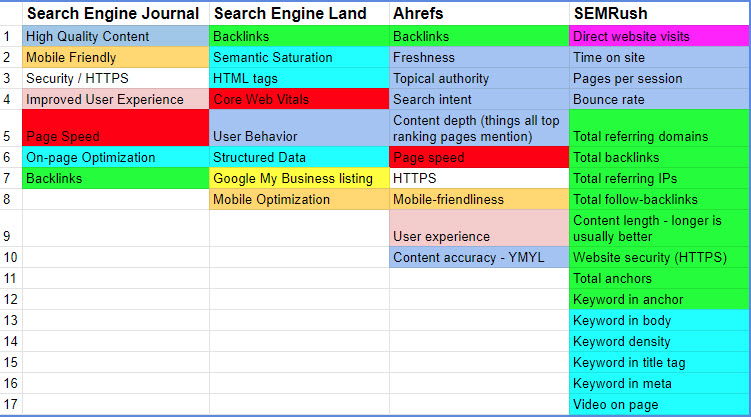
Digital marketing agencies are continually challenged in keeping up with the latest website ranking factors.
Regardless of our attentiveness to attend now-virtual conferences, keep up with the top news sources, and research information from search engines and SEO tool providers, changes can still get missed. When that happens, the same old processes continue without offering the best return on investment for its clients.
SEMRush Ranking Factors
In an effort to bring you some updated news about SEO, we checked out the Ranking Factors SEMRush Study 2.0. Although published in 2017, they’ve updated it for 2020. Here’s a summary:
Ranking Factor #1 – Number of direct website visitors

Regardless of the marketing efforts used to bring visitors to your site, you still need an extremely high number of direct website visitors. Just as a retail store needs to first attract and then retain loyal customers, websites need to do the same.
Ranking Factor #2 – Time on site

The longer you spend in a store, the more likely you are to buy more. Or at least find value in being there. The same is true for your website. By providing great content that keeps visitors there, you’ll improve your ranking to bring in even more visitors.
Ranking Factor #3 – Pages per session

Related to time on site, pages per session also clues Google in on the value that visitors receive from your site. Add valuable content with intuitive paths for visitors to find it, and you will improve your pages per session score along with your keyword positions.
Ranking Factor #4 – Bounce rate

The definition of bounce rate has changed, along with its effect on ranking. Formerly, bounce rate described a visitor to a site who didn’t spend much time there and quickly left.
Now, it refers to a visitor that only went to one page on the site. They could spend 10 minutes on that page, but if they don’t click on anything else that leads them to a second page on your site, it is considered a bounce. If you only have a one-page site, your web person did you a big disservice!
Ranking Factors #5 to #8 – All Link-Related

Ranking Factor #5 – Total referring domains. More precisely, this factor measures the number of domains that link to your website, not the total number of links. The same domain might link 20 times, but it only counts as 1 referring domain.
Ranking Factor #6 – Total backlinks. This counts all 20 links in the example of the referring domain above.
Ranking Factor #7 – Total referring IPs. Different countries are associated with different IP numbers. For global organizations, it is important for ranking purposes to obtain backlinks from many different countries.
Ranking Factor #8 – Total Follow-Backlinks – If a site linking to your site has a “no-follow” attribute, it still counts in the ranking factors 5 through 8 above. Only here in position 8 are the links without the attribute counted. This is a big change since it increased the importance of no-follow links.
Note that factors #11 and #12 below also refer to backlinks. All backlink factors impact one another, so none can be ignored. First positions on high-ranking keywords are still occupied by sites with the richest backlink portfolios.
Ranking Factor #9 – Content length. Longer is usually better. For short keywords, users expect summary content, while they expect longer content for long-tail searches. Google has figured this out and ranks accordingly.
Ranking Factor #10 – Website security (having HTTPS). This is absolutely essential, even if we disregard ranking. Do it.
Ranking Factor #11 – Total anchors. An anchor refers to the actual words that are clicked on when linking to your site. While this factor counts the total anchors, variety is required as noted in the ranking factor below–not the same words for every link.

Ranking Factor #12 – Keyword in anchor. Of all backlink factors, having the target keywords in the anchor has the least influence. For short keyword phrases, avoid putting the exact target keyword in your anchor link!
It’s ok for long-tail keywords to contain one anchor with the exact words. While using keywords in anchor text multiple times has been known for some time, this is a more distinct clarification.
Ranking Factor #13 – Keyword in body. Over 75% of the pages that ranked for a high-volume keyword had the keyword in the body. The higher a keyword’s volume was, the more pages included the keyword in their copy. Continue this practice, but keep long-tail keywords to only one or two instances on the page. As always, keyword stuffing is definitely old school.
Ranking Factor #14 – Keyword density. Described in the above factor. Avoid adding the exact keyword too many times, especially if there isn’t much text on the page.
Ranking Factor #15 – Keyword in title. Continue this practice. It affects ranking, especially on higher volume keywords.

Ranking Factor #16 – Keyword in meta description.
The occurrence of keywords in the meta description did not influence the page rankings in this study.
Less than 50% of the pages that ranked for a high-volume keyword had the keyword in their meta description. For low-volume keywords, only 15% had the keyword in their meta description.
It is true that Google will bold the instances of the search in both the title and description tag, which can make the link more clickable when bolded. Our advice is to make the meta description useful and something a user wants to click on, but don’t insist on putting the keyword in the copy.

Ranking Factor #17 – Video on page
Having video on your site does not directly seem to influence rankings, but it can indirectly influence ranking by increasing time on site and reducing bounce rate.
Doubts about the data
After thoroughly reviewing the SEMRush study, we had some doubts. For example, they show the Number of Direct Visits to a site as the #1 ranking factor for SEO. What? That was news to us and is a real game changer. Or is it?
We also had doubts about what was missing from the SEMRush data: Mobile Friendliness, Structured Data, and Page Speed, to name a few. So we checked out three other authoritative sources on SEO:
- Search Engine Journal – Top 7 Ranking Signals: What REALLY Matters in 2020
- Search Engine Land – 8 major Google ranking factors – SEO guide (9/15/20)
- Ahrefs – 10 Google Ranking Factors You Shouldn’t Ignore (updated 10/9/20)
Here’s a chart showing the order of priority in which each expert placed the factor. The colors attempt to match the same factor in another column (apologies to those of you who are color-blind). It clearly points out the differences of opinion among well-respected search experts:

Unfortunately, we found the factors were like comparing apples to oranges. Some lined up nicely, while others did not. For instance:
- High-Quality Content often included items from User Experience or User Behavior and vice versa.
- Structured Data was included in Page Optimization by Search Engine Journal and Ahrefs, and in Quality Content by Search Engine Land.
- Rather than just saying “Backlinks,” the SEMRush report segregated them into 8 “types” of backlinks.
There are also numerous factors that can result in others. For instance, while Direct Website Visits was SEMRush’s #1 factor, the #1 factors of Backlinks and Quality Content indicated by the other experts may well result in a high number of visits. It can be mind-boggling.
With all the changes in SEO today, you can count on Top Of The List to be at the forefront of the latest updates. We adjust our marketing strategies to ensure the best use of our time in achieving top rankings for our clients. In the end, it’s all about what works to obtain the best results for each website!
About the Author

Bev founded Top Of The List in 2006 and has over 25 years of experience working with technology. In her free time, she competes in dog agility competitions with her Golden Retrievers, Cosmo, and Finn.




